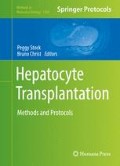Abstract
Liver transplantation has been established as a curative therapy for acute and chronic liver failure, as well as liver-based inherited metabolic diseases. Because of the complexity of organ transplantation and the worldwide shortage of donor organs, hepatocyte transplantation is being developed as a bridging therapy until donor organs become available, or for amelioration of inherited liver-based diseases. The Gunn rat is a molecular and metabolic model of Crigler–Najjar syndrome type 1, which is characterized by lifelong unconjugated hyperbilirubinemia due to the lack of uridinediphosphoglucuronate glucuronosyltransferase-1 (UGT1A1)-mediated bilirubin glucuronidation. Gunn rats are convenient for evaluating the effect of hepatocyte transplantation or gene therapy, because the extent of UGT1A1 replacement can be assessed by serial determination of serum bilirubin levels, and excretion of bilirubin glucuronides in bile provide definitive evidence of the function of the transplanted hepatocytes or the effect of gene therapy. The core techniques involved in hepatocyte transplantation in Gunn rats are discussed in this chapter.
Access this chapter
Tax calculation will be finalised at checkout
Purchases are for personal use only
References
Aberg F, Isoniemi H, Hockerstedt K (2011) Long-term results of liver transplantation. Scan J Surg 100:14–21
Dhawan A, Strom SC, Sokal E, Fox IJ (2010) Human hepatocyte transplantation. Methods Mol Biol 640:525–534
Demetriou A, Levenson SM, Whiting J, Feldman D, Moscioni AD, Kram M et al (1986) Replacement of hepatic functions in rats by transplantation of microcarrier-attached hepatocytes. Science 233:1190–1192
Puppi J, Strom SC, Hughes RD, Bansal S, Castell JV, Dagher I et al (2012) Improving the techniques for human hepatocyte transplantation: report from a consensus meeting in London. Cell Transplant 21:1–10
Fox IJ, Roy-Chowdhury J, Kaufman SS, Goertzen TC, Roy-Chowdhury N, Warkentin PI et al (1998) Treatment of Crigler-Najjar syndrome type I with hepatocyte transplantation. N Engl J Med 333:1422–1428
Patil PB, Begum S, Joshi M, Keman MI, Olausson M, Sumitran-Holgersson S (2014) Phenotypic and in vivo functional characterization of immortalized human fetal liver cells. Scand J Gastroenterol 49:705–714
Roy-Chowdhury J, Grossman M, Gupta S, Roy Chowdhury N, Baker JR Jr, Wilson JM (1991) Long term improvement of hypercholesterolemia after ex vivo gene therapy in LDL-receptor deficient rabbits. Science 254:1802–1805
Kawashita Y, Guha C, Moitra R, Wang X, Fox IJ, Roy-Chowdhury J et al (2008) Hepatic repopulation with stably transduced conditionally immortalized hepatocytes in the Gunn rat. J Hepatol 49:99–106
Basma H, Soto-Gutiérrez A, Yannam GR, Liu L, Ito R, Yamamoto T et al (2009) Differentiation and transplantation of human embryonic stem cell-derived hepatocytes. Gastroenterology 136:990–999
Chen Y, Li Y, Wang X, Zhang W, Sauer V, Chang C-J et al (2015) Amelioration of hyperbilirubinemia in Gunn rats after transplantation of human induced pluripotent stem cell-derived hepatocytes. Stem Cell Rep 5:22–30
Jiang J, Salido EC, Guha C, Wang X, Moitra R, Liu L et al (2008) Correction of hyperoxaluria by liver repopulation with hepatocytes in a mouse model of primary hyperoxaluria type-1. Transplantation 85:253–1260
Yannam GR, Han B, Setoyama K, Ito R, Brooks JM, Guzman-Lepe J et al (2014) A non-human primate model of human radiation-induced venocclusive liver disease and hepatocyte injury. Int J Radiat Oncol Biol Phys 88:404–411
Roy-Chowdhury N, Kondapalli R, Roy Chowdhury J (1993) The Gunn rat: an animal model for inherited deficiency of bilirubin glucuronidation. In: Cornelius CE (ed) Animal models in liver research. Academic Press, New York, pp 150–175
Roy-Chowdhury J, Huang TJ, Kasari K, Lederstein M, Arias IM, Roy-Chowdhury N (1991) Molecular basis for the lack of bilirubin-specific and 3-methylcholanthrene-inducible UDP-glucuronosyltransferase activities in Gunn rats: the two isoforms are encoded by distinct mRNA species that share an identical single base deletion. J Biol Chem 266:18294–18298
Guha C, Sharma A, Gupta S, Alfieri A, Gorla GR, Gagandeep S et al (1999) Amelioration of radiation-induced liver damage in partially hepatectomized rats by hepatocyte transplantation. Cancer Res 59:5871–5874
Zhou H, Dong X, Kabarriti R, Chen Y, Avsar A, Wang X et al (2012) Single liver lobe repopulation with wildtype hepatocytes using regional hepatic irradiation cures jaundice in Gunn rats. PLoS One 7(10):e46775
Ilan Y, Roy-Chowdhury N, Prakash R, Jona V, Attavar P, Guha C et al (1997) Massive repopulation of rat liver by transplantation of hepatocytes into specific lobes of the liver and ligation of portal vein branches to other lobes. Transplantation 64:8–13
Iyanagi T, Watanabe T, Uchiyama Y (1989) The 3-methylcholanthrene-inducible UDP-glucuronosyltransferase deficiency in the hyperbilirubinemic rat (Gunn rat) is caused by a -1 frameshift mutation. J Biol Chem 264:21302–21307
Roy-Chowdhury J, Roy-Chowdhury N, Gartner U, Wolkoff AW, Arias IM (1982) Bilirubin diglucuronide formation in intact rats and in isolated Gunn rat livers. J Clin Invest 69:595–603
Acknowledgments
This work was supported in part by grants NIH RO1 1RO1 DK092469-01 (NR-C); NYSTEM CO24346 and CO26440 (JR-C); NIH 1PO1 DK 096990-01 (IJF and JR-C); and NIH P30 DK 41296-26 (Liver Pathobiology and Gene Therapy Research Core Center).
Author information
Authors and Affiliations
Corresponding authors
Editor information
Editors and Affiliations
Rights and permissions
Copyright information
© 2017 Springer Science+Business Media New York
About this protocol
Cite this protocol
Polgar, Z., Li, Y., Li Wang, X., Guha, C., Roy-Chowdhury, N., Roy-Chowdhury, J. (2017). Gunn Rats as a Surrogate Model for Evaluation of Hepatocyte Transplantation-Based Therapies of Crigler–Najjar Syndrome Type 1. In: Stock, P., Christ, B. (eds) Hepatocyte Transplantation. Methods in Molecular Biology, vol 1506. Humana Press, New York, NY. https://doi.org/10.1007/978-1-4939-6506-9_9
Download citation
DOI: https://doi.org/10.1007/978-1-4939-6506-9_9
Published:
Publisher Name: Humana Press, New York, NY
Print ISBN: 978-1-4939-6504-5
Online ISBN: 978-1-4939-6506-9
eBook Packages: Springer Protocols

